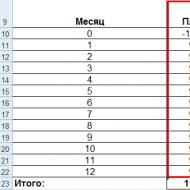
What is the difference between VTB and VTB 24?
VTB and VTB 24 banks are among the 5 largest financial institutions in Russia. But not everyone knows what is the difference between VTB and VTB 24 and consider these banks to be one. In fact, both institutions are part of an international banking group, which also includes two more Russian banks, about a dozen foreign ones, a leasing company, an insurance company, a pension fund, and so on.
History of VTB Bank
In the rating of the largest banks in Russia, VTB Bank follows immediately after Sberbank (the number of net assets and the amount of authorized capital are taken into account). This is one of the state systemically important banks - more than 60% of the shares of which are owned by the state, the rest is distributed among enterprises and private investors.
To understand the difference between VTB 24 and VTB, you need to make an excursion into the history of both institutions.
VTB appeared in 1990 at the initiative of the Ministry of Finance of the RSFSR, it was supposed to perform the functions of foreign trade. Created as a closed joint-stock company, Vneshtorgbank was transformed into an open joint-stock company in 1998. The Central Bank acquired almost 97% of the shares, in 2002 its share was transferred to the Ministry of Property Relations.
In 2006, in the course of rebranding, Vneshtorgbank acquired its modern abbreviated name - VTB.
In 2007, VTB was the first among domestic banks to conduct an IPO of its shares, and more than 120,000 Russians became owners of the institution's securities. In 2011 and 2013, the bank issued additional securities, as a result, the state's share fell to the current 60%.
It is one of the market leaders in terms of the number of affiliated banks.
Major Acquisitions:
- 1996 - Gazinvestbank (subsequently transferred to Evrogazinvet);
- 2004 - Guta-Bank (subsequently transformed into VTB 24), Armsberbank (transformed into VTB (Armenia));
- 2005 - PSB (on its basis, the North-West division of VTB was created);
- 2006 - Mriya;
- 2007 - Slavneftebank (transformed into VTB Belarus);
- 2013 – TransCredit Bank (part of VTB 24);
- 2016 - Leto-Bank (transformed into Post-Bank);
- 2016 - Bank of Moscow.
In addition, VTB is actively acquiring foreign banks and transforming them into its structural divisions. In total, the bank has 34 branches opened in 18 Russian cities, two more branches are located in India and China, and the bank has a representative office in Italy.

History of VTB 24
Bank VTB 24 appeared in 2005 as a subsidiary of VTB. It was created on the basis of Guta-Bank (the current regional Tver Guta-Bank has nothing to do with it) and was originally called Vneshtorgbank Retail Systems. In 2006, it received its current name.
It should be noted that even in its first name, the difference between VTB and VTB 24 was emphasized - the first served large corporate clients, the second specialized in the provision of retail services, such as:
- opening a settlement account for private individuals;
- issuance of loans to individuals, individual entrepreneurs and representatives of SMEs;
- participation in mortgage projects;
- accepting deposits from the public;
- implementation of salary projects;
- issue of debit and credit cards.
In a short time, thanks to the support of the parent organization and competent management, VTB 24 took the second place in Russia in terms of prevalence after Sberbank (if we evaluate the size of the regional network and the number of employees). The bank has more than 1,000 representative offices in 72 regions of the country. In terms of the volume of loans issued and attracted deposits, VTB 24 also ranks second in Russia after Sberbank.
The consolidation of VTB 24 also took place due to the accession of regional banks to it, the following were attached to it:
- 2011 - after the liquidation of the North-West division of VTB, its branch network went to VTB 24,
- 2011 – KIT Finance mortgage package;
- 2012 - Leto Bank;
- 2013 - TransCreditBank.
On the basis of Leto Bank, in 2016, a subsidiary bank Post Bank was created, 50% plus 1 share belongs to VTB 24, 50% minus 1 share belongs to Russian Post.

The difference between VTB Bank and VTB 24
The difference in banks VTB and VTB 24 lies in the fact that the main line of work. The first of them is engaged in servicing representatives of exceptional large businesses, and the second - private clients. VTB Bank is actively engaged in investments in banking and real estate, trades in securities through VTB Capital Holding, and provides registrar services.
Thus, what is the difference between VTB and VTB 24 - mainly in the field of activity.
VTB Bank of Moscow
Since 2011, VTB has been actively acquiring shares of the Bank of Moscow, in 2014 it became the owner of a controlling stake in the institution and began the process of integration in order to develop the retail business. In 2016, the merger was completed, 70% of the assets were transferred to the balance of VTB, 30% became the basis of the capital of the new bank - VTB Bank of Moscow.
The difference between VTB 24 and VTB Bank of Moscow is that VTB 24 is a broadly independent bank with its own financial policy, while VTB Bank of Moscow is a division of VTB through which the bank provides retail services to individuals and small businesses. business.
Key directions of VTB Bank of Moscow:
- private lending;
- small business lending;
- deposits;
- settlement and cash services;
- salary cards.
Thus, since 2016, VTB Bank has been providing retail services through VTB Bank of Moscow, while generally remaining a bank exclusively for large businesses. VTB 24 continues to work with the public and businessmen.
Composition of the VTB Group
The VTB banking group includes more than 20 financial companies, including those described above. The difference between VTB Bank and VTB 24 and other banks is that VTB is the parent bank for all of them, it (or its structures) owns from 50% plus one share to 100% of the shares of these institutions.
In addition to these banks, the structure of the group includes organizations of various profiles, for example, non-state pension funds, a leasing company, a processing center (issuing cards), investment groups, a management company (realizes units of mutual funds for private investors), etc.

Conclusion
Thus, answering the question, what is the difference between VTB and VTB 24, it can be noted that VTB specializes in serving exclusively large corporate clients, while the rest of the group's banks provide retail services to citizens and representatives of medium and small businesses. Since 2016, VTB has expanded the scope of its activities, now it conducts retail business through VTB Bank of Moscow, but does not provide services directly to individuals. VTB has a small branch network and operates in more than a dozen countries. VTB 24 is actively represented on the Russian market, has more than 1,000 branches throughout Russia, and ranks second after Sberbank in terms of the volume of loans issued and deposits accepted.
















